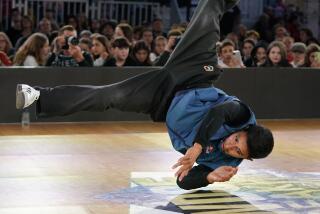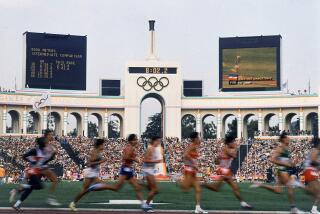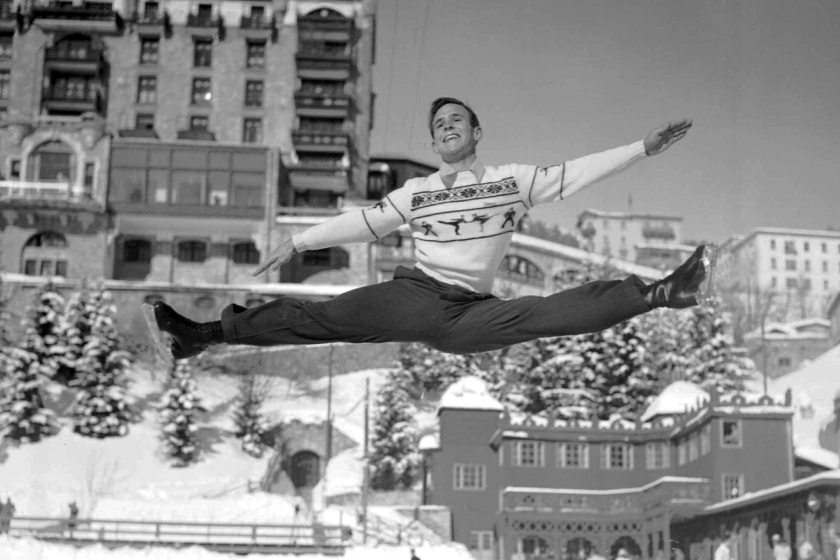Obscure Sprinter’s Rise, Fall Symbolize Doping Nightmare : Track & field: Efforts to advance sport continually undermined by drug incidents.
- Share via
PARIS — He comes from Sierra Leone, a small African country with such an impoverished Olympic committee that it was unable to provide him with anything other than a track and field singlet, shorts and a warm-up suit for the recent Commonwealth Games. Embarrassed because he had no fashionable blazer like the athletes from other countries, he refused to march in the opening ceremony.
He was not missed. Few among the crowd that day in Victoria, Canada, had ever heard of Horace Dove-Edwin, a young sprinter with an unremarkable personal best time in the 100 meters of 10.34 seconds.
Within three days, he emerged not only as one of track and field’s most promising new faces by finishing second to British Olympic champion Linford Christie in the 100 meters but also as an example to athletes from his and other developing nations.
The Royal Commonwealth Society of Canada presented him with a special citation, which read: “His joy at winning the silver medal, the first for his country, was communicated to the whole crowd. A wonderful tribute to his nation.”
The fact that he ran the race in 10.02, an astonishing improvement over his previous best, should have set off sirens in the heads of those who follow track and field, but even if it had, they could not have been heard over the applause for Dove-Edwin, for the training camp in La Grange, Ga., established to assist Third World athletes and for the International Olympic Committee, which had paid for him to attend.
Before the end of the fortnight, reporters who had promoted the story of the blazer-less sprinter with blazing speed to folk legend status were called together in Victoria for the announcement that Dove-Edwin had tested positive for stanozolol, the same anabolic steroid that felled Canadian sprinter Ben Johnson during the Olympic Games at Seoul.
That was six years ago. As current stars such as Christie, British hurdlers Colin Jackson and Sally Gunnell, U.S. long jumper Jackie Joyner-Kersee, Cuban high jumper Javier Sotomayor, Ukrainian pole vaulter Sergei Bubka and Algerian miler Noureddine Morceli compete here today in the Mobil Grand Prix Final near the end of another outdoor season, they find that their efforts to advance the sport on the track continue to be undermined by drugs.
It has been particularly frustrating for British Athletic Federation officials, who were among the first to declare war against anabolic steroids and other banned performance-enhancing substances and have armed themselves with frequent random, unannounced tests and severe penalties.
Within recent weeks, however, six British track and field athletes have tested positive, and one, world-class half-miler Diane Modahl, was discovered to have a level of the male hormone testosterone in her system that was four times higher than Johnson’s when he was suspended for his second offense in 1993.
Furthermore, BAF officials, as often occurs with their U.S. counterparts, find themselves in the awkward position of defending Modahl because of alleged testing irregularities in a highly publicized dispute with International Amateur Athletic Federation officials that threatens to obscure next week’s World Cup in London.
“It seems a ridiculous situation where drugs is leading the 9 o’clock and the 10 o’clock news; things are not that bad,” said Jackson, the world record-holder in the 110-meter high hurdles. “I have just clocked 13.02, and all people want to talk about is drugs.”
In an interview during this week’s Olympic Centennial Congress, IAAF President Primo Nebiolo said: “I want to stress that doping is a very serious problem. But it is not the problem of track and field. Doping is the problem of all sports.”
He pointed to recent headlines associating banned substances with cycling, swimming, diving, weightlifting, boxing and soccer. But, he emphasized, IAAF officials are not underestimating the problem within their sport.
They are, he said, aggressively pursuing athletes who use drugs, describing a system of flying hit squads that arrive unannounced in countries and select athletes for testing during training.
But as important as it might be to police the athletes, it has become increasingly apparent that it is equally necessary to watch the watchdogs. IOC officials contend that steps have been taken to prevent a situation such as occurred 10 years ago during the Los Angeles Olympics, in which documents revealing positive tests were destroyed. At other levels, however, irregularities remain.
Modahl allegedly tested positive on June 18, but the initial report remained on the desk of a vacationing Portuguese track and field official for five weeks before it was passed on to the IAAF. The runner was not summoned for testing of her “B” sample until last Monday.
“Our lawyer is working very hard on the case,” said Modahl’s husband, Vincente, thus guaranteeing another long, depressing off-season for the sport’s faithful.
More to Read
Go beyond the scoreboard
Get the latest on L.A.'s teams in the daily Sports Report newsletter.
You may occasionally receive promotional content from the Los Angeles Times.






